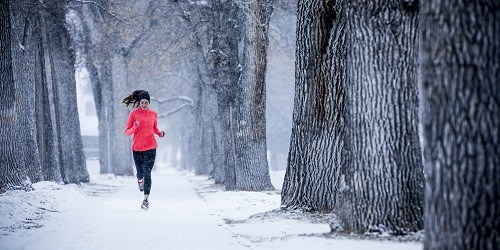Commonly Made Mistakes While Running In The Winter
- Posted on

Winter running has plenty of physical and mental benefits.
Running in tough conditions helps to build resilience and endurance. Here are the common mistakes to avoid while running in the toughest season of the year:
1. Dehydration
2. Running race pace instead of surviving the runs
3. Commit to some running buddies
4. Overdressing or under-dressing
5. Not having a game plan when it comes to training for events
6. Bad footwear choices
Dehydration:
While running in the winter the temperature will vary from above zero to way below zero. It is still critical to hydrate. You will still sweat and loose fluids from your body. It is just as important to replenish electrolytes as would for summer time running. Try to drink 2 to 3 litres of fluids daily. Best word of advice is to incorporate a sport hydration drink mix such as Skratch, Nuun, and BioSteel into your daily hydration. All of these will help keep you from bonking on your run and are very effective for pre-run, post-run and recovery days.
Slow Down:
Winter running is about survival and not putting your body at risk. Most common over use injuries happen from slipping and falling running on snow and ice. If you have to hit your targets for your event, run indoors on a track or a treadmill. If running on a treadmill for three hours to get ready for a marathon seems crazy try cycling on a stationary bike or running in a pool as they are great alternative training choices. Rule of thumb: the number of minutes it would take you to run your target distances should equal the number of minutes you cycle, swim and run indoors.
Don't run it alone! Find some running buddies as a way to stay accountable:
We guarantee that you won't bail on a run if you have some good buddies out there conquering some blustery miles with you. Finding some reliable running partners is the best way to stay accountable to your running, and also a great way to make some special bonds with friends. Having a nice warm breakfast planned for afterward is the best reward, and the coffee always taste better after a hard run!
I never know what to wear for my run in cold temperatures. How do I dress?:
No two people react to the cold the same to cold temperatures. There is no easy answer. Find out with experimentation what best works for you. Try your entire wardrobe on your runs and remember the best combination for the conditions.
Rules of thumb: running in cold temperatures are ok but windchill is what's going t. Running at 0 degrees without wind can be a comfortable run. Running at 0 degrees with wind chill of -10 can be down right unbearable. Layer appropriately and protect all exposed skin.
Windy conditions? Wear a base layer top and bottom with nylon wind proof or resistant on the outer layer. Protect all exposed skin, keep your ears, face and hands protected. Your winter best friends are a balaclava and a pair of mitts/gloves. Remember to use skin care products for wind and sun protection. Protect eyes with sunglasses. Many have exchangeable lenses. Clear lenses for the dark, darker lenses for the bright light, and yellow happy lenses for twilight.
Coach, my event is months away, do I really need a plan?:
Yes, running with a plan can help you keep your focus for your event. A day, a week, a month can zoom bye and then all of a sudden your event is upon you and you find yourself out of shape. Take the time leading up to the heart of your training for your event to learn how to run with better form, more speed and find your running rhythm. Short fast runs can give you that mental lift with achieving smaller goals. Your fastest one km, two km or from the local coffee shop to home.
Are there shoes made specifically for winter running?:
Yes! We carry many brands that have shoes geared for winter running. You will certainly be much more comfortable and happy if you invest in a pair of shoes that will get you through wintery conditions. You will also be more likely to stick to your training. Winter shoes are made of materials that are waterproof, windproof and have more aggressive treads that help with traction. Falling down is not an option!
